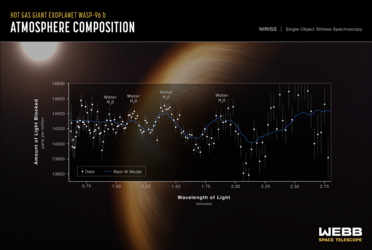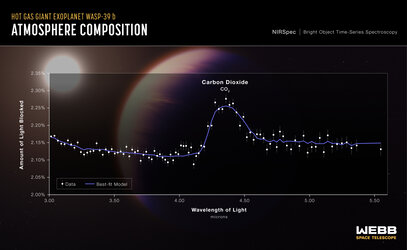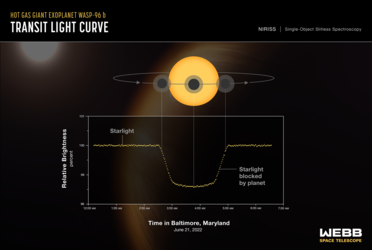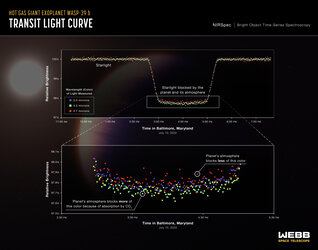

WASP-39 b atmospheric composition (NIRSpec, NIRCam and NIRISS)
The atmospheric composition of the hot gas giant exoplanet WASP-39 b has been revealed by the NASA/ESA/CSA James Webb Space Telescope. This graphic shows four transmission spectra from three of Webb’s instruments operated in four instrument modes. All are plotted on a common scale extending from 0.5 to 5.5 microns.
A transmission spectrum is made by comparing starlight filtered through a planet’s atmosphere as it moves in front of the star, to the unfiltered starlight detected when the planet is beside the star. Each of the data points (white circles) on these graphs represents the amount of a specific wavelength of light that is blocked by the planet and absorbed by its atmosphere. Wavelengths that are preferentially absorbed by the atmosphere appear as peaks in the transmission spectrum.
The blue line is a best-fit model that takes into account the data, the known properties of WASP-39 b and its star (e.g., size, mass, temperature), and assumed characteristics of the atmosphere. Researchers can vary the parameters in the model – changing unknown characteristics like cloud height in the atmosphere and abundances of various gases – to get a better fit and further understand what the atmosphere is really like.
At upper left, data from NIRISS shows fingerprints of potassium (K), water (H2O), and carbon monoxide (CO). At upper right, data from NIRCam shows a prominent water signature. At lower left, data from NIRSpec indicates water, sulphur dioxide (SO2), carbon dioxide (CO2), and carbon monoxide (CO). At lower right, additional NIRSpec data reveals all of these molecules as well as sodium (Na).





